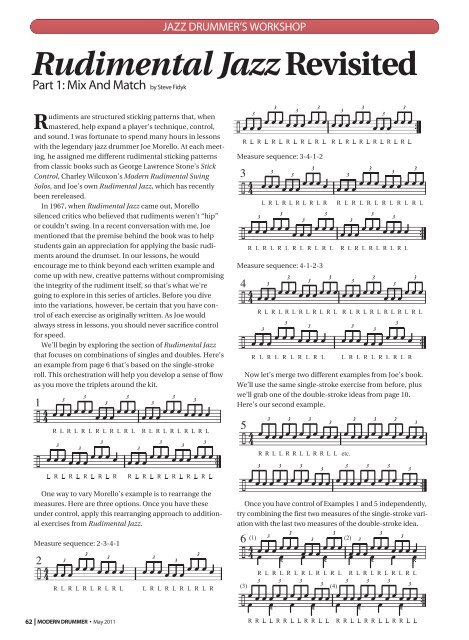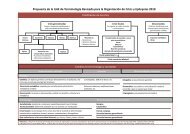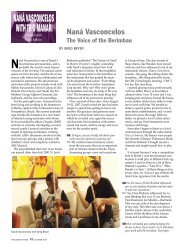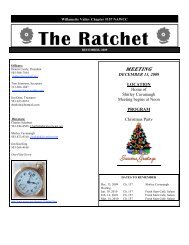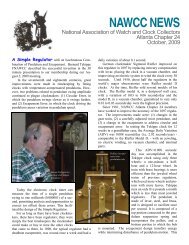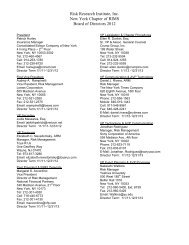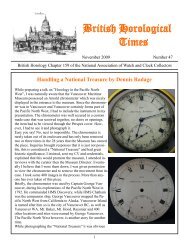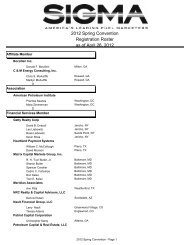Sound, Time, & Creativity - S.F.
Sound, Time, & Creativity - S.F.
Sound, Time, & Creativity - S.F.
You also want an ePaper? Increase the reach of your titles
YUMPU automatically turns print PDFs into web optimized ePapers that Google loves.
62<br />
Rudiments are structured sticking patterns that, when<br />
mastered, help expand a player’s technique, control,<br />
and sound. I was fortunate to spend many hours in lessons<br />
with the legendary jazz drummer Joe Morello. At each meeting,<br />
he assigned me different rudimental sticking patterns<br />
from classic books such as George Lawrence Stone’s Stick<br />
Control, Charley Wilcoxon’s Modern Rudimental Swing<br />
Solos, and Joe’s own Rudimental Jazz, which has recently<br />
been rereleased.<br />
In 1967, when Rudimental Jazz came out, Morello<br />
silenced critics who believed that rudiments weren’t “hip”<br />
or couldn’t swing. In a recent conversation with me, Joe<br />
mentioned that the premise behind the book was to help<br />
students gain an appreciation for applying the basic rudiments<br />
around the drumset. In our lessons, he would<br />
encourage me to think beyond each written example and<br />
come up with new, creative patterns without compromising<br />
the integrity of the rudiment itself, so that’s what we’re<br />
going to explore in this series of articles. Before you dive<br />
into the variations, however, be certain that you have control<br />
of each exercise as originally written. As Joe would<br />
always stress in lessons, you should never sacrifice control<br />
for speed.<br />
We’ll begin by exploring the section of Rudimental Jazz<br />
that focuses on combinations of singles and doubles. Here’s<br />
an example from page 6 that’s based on the single-stroke<br />
roll. This orchestration will help you develop a sense of flow<br />
as you move the triplets around the kit.<br />
One way to vary Morello’s example is to rearrange the<br />
measures. Here are three options. Once you have these<br />
under control, apply this rearranging approach to additional<br />
exercises from Rudimental Jazz.<br />
Measure sequence: 2-3-4-1<br />
MODERN DRUMMER • May 2011<br />
JAZZ DRUMMER’S WORKSHOP<br />
Rudimental Jazz Revisited<br />
2<br />
Part 1: Mix And Match<br />
1<br />
2<br />
by Steve Fidyk<br />
Measure sequence: 3-4-1-2<br />
3<br />
Measure sequence: 4-1-2-3<br />
4<br />
Now let’s merge two different examples from Joe’s book.<br />
We’ll use the same single-stroke exercise from before, plus<br />
we’ll grab one of the double-stroke ideas from page 10.<br />
Here’s our second example.<br />
5<br />
Once you have control of Examples 1 and 5 independently,<br />
try combining the first two measures of the single-stroke variation<br />
with the last two measures of the double-stroke idea.<br />
6
Now play the first two measures of the double-stroke example<br />
followed by the last two measures of the single-stroke<br />
variation.<br />
7<br />
Next, try practicing the previous merged examples backwards.<br />
Here’s Example 6 in reverse.<br />
8<br />
9<br />
And here’s Example 7 played backwards.<br />
You can continue to mix and match measures and phrases<br />
to come up with a multitude of new musical ideas. Try applying<br />
this concept to the remainder of the original examples in<br />
Rudimental Jazz. In part two of this series, we’ll explore ways<br />
to expand on Joe’s paradiddle variations.<br />
Steve Fidyk is the drummer with the Army Blues Big Band<br />
from Washington, D.C., and a member of the jazz faculty at<br />
Temple University in Philadelphia. Fidyk is also the author<br />
of the critically acclaimed book Inside The Big Band Drum<br />
Chart, which is published by Mel Bay.
THE ORIGINAL STANDARD 26 AMERICAN DRUM RUDIMENTS<br />
1) The Long Roll<br />
2) The Five Stroke Roll<br />
3) The Seven Stroke Roll<br />
4) The Flam<br />
5) The Flam Tap<br />
6) The Flam Accent<br />
7) The Flamacue<br />
8) The Drag or Half Drag<br />
9) The Single Drag - or<br />
Single Drag Tap<br />
10) The Double Drag or<br />
Double Drag Tap<br />
11) The Single Paradiddle<br />
. 12) The Double Paradiddle<br />
13) The Flam Paradiddle Y<br />
14) The Flam Paradiddle-diddle<br />
RL R L R R L<br />
> ><br />
bl<br />
I. I I I<br />
11 ..I I<br />
I u I<br />
LLR LLR L RRL RRL R<br />
R L R R L R L L<br />
> w<br />
R L R L R R L R L R L L<br />
LR L R R R L R L L<br />
n 71 I I I I I I I I<br />
1 1 . - I I I II .I I I I I I<br />
I I<br />
.A<br />
L R L R R L L R L R L L R R
15) The Drag Paradiddle #1<br />
16) The Drag Paradiddle #2<br />
17) The Single Ratamacue<br />
18) The Double Ratamacue<br />
19) The TripleRatamacue<br />
20) The Nine Stroke Roll<br />
21) The Ten Stroke Roll<br />
22) The Eleven Stroke Roll<br />
23) The Thirteen Stroke Roll<br />
24) The Fifteen Stroke Roll<br />
25) Compound Strokes<br />
(Lesson No. 25)<br />
26) The Single - Stroke Roll<br />
R LLR L R R L RRL R L L<br />
-<br />
3 5 3 -<br />
LL R L R L RRL R L R<br />
L R L<br />
R L R<br />
R L R L R L R L etc.<br />
In many musical examples, the above 26 rudiments may be found written with altered accents and rhythms to enhance<br />
the artistry of a particular composer's work; however, the examples will still be drawn from the rudiments above. When<br />
performing isolated rudiments, as in an audition or a contest, it is common practice for the chosen rudiment to be played<br />
from slow to fast to slow using gradual accelerandos and decelerandos.<br />
Example: =-<br />
> > > > ><br />
> ><br />
1 ; ; I I - ; ; r I;;;;;;I<br />
n I I I I I I I I I I I I I I I I I 1 1 1 I I 1 I I I I I I I I<br />
II I I I<br />
R L R R L R L L R L R R L R L L R L R R L R L L R L R R L R L L<br />
followed by the opposite to bring the rudiment to a close.
<strong>Sound</strong> Enhanced<br />
A play-along audio file that relates to this article can be<br />
found in the Members Only section of the PAS website<br />
at www.pas.org.<br />
Rhythmic Interpretation,<br />
Articulation Markings and<br />
Musical Shape<br />
By Steve Fidyk<br />
The following interpretation is commonly accepted when performing<br />
eighth-note rhythms in a swing style. �is interpretation<br />
gives a smooth, connected, and legato feeling to the swing<br />
rhythms.<br />
�e tempo and style of a composition can also influence the way<br />
eighth notes are interpreted. Early swing music of the 1920s and ’30s, for<br />
example, has a phrasing that is more closely related to this interpretation:<br />
With arrangements played in a fast bebop style (300 bpm or faster),<br />
the eighth notes are interpreted and performed fairly straight:<br />
No set rules govern the way a particular phrase is to be swung. Each<br />
band has its own rhythmic feel and phrasing style. To recognize this,<br />
listen to the lead players (trumpet 1, trombone 1, and alto 1) and match<br />
their phrasing and accents.<br />
ARTICULATION MARKINGS<br />
As drummers, we cannot play note durations with the accuracy of<br />
a horn player, but we can designate sound sources from the drumset<br />
that best complement the articulation and intensity of a note or phrase.<br />
Often, drummers base their approach to articulation on the duration<br />
or length of a note. �is method promotes that all short notes are to be<br />
played on high sounds like the snare drum, and long notes are voiced on<br />
low sounds like the floor tom or bass drum.<br />
PERCUSSIVE NOTES 30 APRIL 2009<br />
�e following articulation symbols are common in horn parts. �ey<br />
are used as indicators for emphasis.<br />
�is symbol (-) signifies a long attack<br />
(.) or (^) suggests a short attack<br />
An accent (>) can be interpreted long or short, depending upon the<br />
style and context.<br />
A note’s articulation is determined in part by: what section of the<br />
band is playing; the intensity of the phrase; the instrument range (high<br />
or low) in which the phrase is played.<br />
�e key is to listen and allow your ears and musical instincts to point<br />
you in the right direction. Your approach to phrasing and articulating<br />
should always complement the ensemble, and by reading and understanding<br />
these symbols and their meanings, you will bring clarity to the<br />
longer phrases you play.<br />
Below is an example showing a trumpet 1 phrase with articulation<br />
marks.<br />
If we expose the rhythms with articulations, we have a phrase that<br />
illustrates the emphasized horn rhythms. �ese are destination points in<br />
a musical line that create a second tier of accent texture. With just the<br />
articulated rhythm, the phrase looks like this:
Here is a common drumset articulation for this phrase.<br />
By reading and emphasizing the articulated rhythm, you naturally<br />
attain the notes a horn player would give significance to. Now you are<br />
phrasing and articulating with the band!<br />
DYNAMIC EXPRESSION AND MUSICAL SHAPE<br />
Each note we play has a dynamic. Percussionists achieve dynamic<br />
diversity through their stroke, motion, and stick direction. �e closer<br />
the sticks are to the instrument when we begin our stroke, the softer the<br />
attack will be. Conversely, a stroke begun further away from the drum<br />
produces a louder dynamic.<br />
�e speed or velocity at which we throw the stick to the instrument<br />
can also influence the way a phrase is felt and heard. A faster stick<br />
velocity can produce rhythms with more intensity and forward<br />
momentum. As you practice, try varying your stick height and velocity<br />
and listen carefully to the differences in dynamic inflection. �is<br />
approach can help bring expression to the written notation.<br />
Music of all styles or genres has shape. As a piece of music develops,<br />
phrases ascend with intensity or descend, creating different musical<br />
textures and moods. As you read, you will notice that drum parts from<br />
big band arrangements have a multitude of single “flat line” rhythms that<br />
do not indicate shape.<br />
Below is an example of a typical band figure from a drum part. Does<br />
the musical line ascend or descend? It’s impossible to tell by observing<br />
the drum part alone.<br />
Flat line drumset section figure<br />
Below are the same two measures from the trumpet one part:<br />
�e line drawing below approximates the shape of the above multiple-note<br />
trumpet figure. You can try this by drawing an imaginary line<br />
through each note head in a phrase and mirror the shape on the drums<br />
and cymbals.<br />
Musical examples from Inside the Big Band Drum Chart by Steve Fidyk<br />
Copyright © 2008 Mel Bay Publications, Inc.<br />
All rights reserved. Used with Permission.<br />
Steve Fidyk is a jazz drummer, author, and educator who has toured<br />
and recorded with Maureen McGovern, New York Voices, Cathy Fink<br />
and Marcy Marxer, �e Capitol Bones, and �e Taylor/Fidyk Big Band.<br />
He is currently the drummer with the Army Blues Jazz Ensemble from<br />
Washington D.C. Fidyk has authored �e Drum Set SMART Book, Inside<br />
the Big Band Drum Chart, Jazz Drum Set Independence 3/4, 4/4, and 5/4<br />
<strong>Time</strong> Signatures, and an instructional DVD, Set Up and Play!, all published<br />
by Mel Bay. He has also recorded over 75 jazz play-along volumes<br />
for the Hal Leonard Corporation. Fidyk is a member of the jazz faculty<br />
at Temple University in Philadelphia. PN<br />
PERCUSSIVE NOTES 31 APRIL 2009
In order to evolve as musicians, it is essential to digest concepts<br />
and techniques of the great drummers. Transcribing,<br />
analyzing, listening to recordings, attending live performance,<br />
and practicing transcriptions can help increase your understanding<br />
of a particular player’s style in greater depth.<br />
But when it comes to adapting the vocabulary developed by<br />
the great jazz drummers into your own style, you don’t want to<br />
just repeat their licks and phrases verbatim. To become truly<br />
fluent in the jazz drumming language, you must be able to mix<br />
and match the rhythms and techniques so that you can ultimately<br />
make your own statements.<br />
Transcribed examples provide a wealth of material from<br />
which to learn musical phrases. Doing your own transcribing<br />
can help you understand how and why these phrases were<br />
played. But whether you are working from transcriptions you<br />
have done yourself or transcriptions that have been published<br />
elsewhere, playing the transcription as written is just the first<br />
step.<br />
Here are three four-measure solo examples rooted in the<br />
bebop tradition.<br />
/<br />
PERCUSSIVE NOTES 20 FEBRUARY 2000<br />
Learning the Jazz Drumming<br />
Language Through Transcriptions<br />
BY STEVE FIDYK<br />
¿ œ œ œ ¿ œ ¿<br />
hi-hat bass drum large tom snare stick shot small tom ride cym.<br />
œ œ<br />
=<br />
3<br />
œ ‰ œ<br />
PERCUSSIVE NOTES<br />
ADVERTISING DEADLINES<br />
ISSUE SPACE FILM/ ART<br />
April Jan. 26 Feb. 9<br />
June Mar. 29 Apr. 12<br />
August May 31 June 14<br />
October June 26 Aug. 9<br />
December Sept. 27 Oct. 11<br />
For More Information Call (580) 353-1455<br />
e-mail: percarts@pas.org<br />
/4 4<br />
1<br />
/<br />
/4 4<br />
2<br />
/<br />
/4 4<br />
3<br />
¿ œ œ œ œ œ œ œ œ œ ¿ œ œ œ ‰ œ ><br />
3 3 3 3 ><br />
œ œ œœ<br />
œ œœ<br />
œ œœ<br />
œ œ<br />
¿<br />
œ ‰ ¿ ‰ j > 3<br />
œ œ œ œ œ > œ<br />
3<br />
3<br />
œ œ œ œ œ œ œ<br />
œ ‰ œ ><br />
/ œ œ<br />
> 3<br />
3 > 3 3<br />
œœ œ<br />
œ<br />
œ œœ<br />
œ ¿ œ<br />
œ œ œ<br />
‰ j<br />
œ<br />
3<br />
œ œ œ > œ > œ<br />
3<br />
¿ ¿ œ<br />
3<br />
œ œ œ<br />
3<br />
œ œ œ ><br />
3<br />
œ œ œ<br />
œ œ ‰ œ œ œ ‰ œ œ œ œ œ œ œ ¿<br />
3<br />
œ œ ‰ œ œ ‰ œ<br />
3<br />
3<br />
3<br />
œ œ<br />
œ œ<br />
œ œ<br />
œ œ œ<br />
3<br />
œ œ œ<br />
1. First, practice each example on a single plane (e.g., a drum<br />
pad or snare drum) to ensure accuracy of note values.<br />
2. Play each four-measure example as written, adding the following<br />
hi-hat ostinatos.<br />
A<br />
/4<br />
4 Œ<br />
¿<br />
Œ<br />
¿<br />
3. Now, try juxtaposing each example by starting the fourmeasure<br />
phrase on beat one of measures two, three, and four.<br />
For example, this is the way four-bar phrase number 2 looks<br />
when it starts on beat one of measure two.<br />
B<br />
¿ ¿ ¿ ¿
4 4 œ > œ<br />
/ ‰ j<br />
œ<br />
3<br />
œ œ œ > œ > œ<br />
3<br />
¿ ¿ œ<br />
3<br />
œ œ œ<br />
3 > 3<br />
œ œ œ œ œ œ<br />
3<br />
œ œ œ œ<br />
œ ‰ œ ><br />
3<br />
œ œ<br />
œ<br />
¿<br />
œ ‰ ¿ ‰ j > 3<br />
œ<br />
œ œ œ<br />
Shifting the departure point makes the four-measure phrase<br />
sound and feel completely different. Each example has a total of<br />
sixteen departure points to choose from: four beats per measure<br />
times four measures equals sixteen points. This “circular fours”<br />
approach allows you to come up with new solo phrases based on<br />
the original example.<br />
Now try playing four-bar phrase number 2 starting on beat<br />
one of measure three, and then start on beat one of measure<br />
four. Then incorporate the hi-hat ostinatos.<br />
The next step is to combine examples. Here is four-bar<br />
phrase number 1, measures one and two, combined with fourbar<br />
phrase number 3, measures three and four.<br />
/4 4 ¿ œ œ œ œ œ œ œ œ œ ¿ œ œ œ ‰ œ ><br />
/ œ œ<br />
3<br />
œ œ ‰ œ œ ‰ œ<br />
3<br />
œ œ œ<br />
3<br />
œ œ œ<br />
3<br />
œ œ œ<br />
3<br />
œ œ œ<br />
You can expand each note value within the four-measure<br />
phrase. For example, written quarter notes would become half<br />
notes; eighth notes would become quarter notes; eighth-note<br />
triplets would become quarter-note triplets. By expanding each<br />
note value, the four-measure phrase becomes an eight-measure<br />
phrase. Here is four-bar phrase number 3 after being expanded.<br />
/4 4 œ œ Œ œ œ œ Œ œ œ œ œ œ œ œ ˙<br />
3<br />
/ œ œ<br />
œ œ Œ œ œ Œ œ<br />
3 3<br />
œ œ<br />
œ œ œ œ<br />
3<br />
œ œ œ<br />
3<br />
œ œ œ<br />
In addition to expanding the phrase, you can also compress<br />
the phrase. Quarter notes become eighth notes, eighth notes become<br />
sixteenths, and so on. Compressing each note value converts<br />
a four-measure phrase into a two-measure phrase. Here is<br />
four-bar phrase number 1 after being compressed.<br />
/4 4 ¿ œ œ œ œ œ œ œ œ œ ¿ œ œ œ ≈ œ ><br />
/<br />
6<br />
œ œ œ œ œœ<br />
6<br />
6<br />
><br />
œ œ œ œ œ œœ<br />
œ œ<br />
œ ><br />
6<br />
œ œ œœ ¿ ><br />
œ<br />
œ œ œ<br />
PERCUSSIVE NOTES 21 FEBRUARY 2000
PERCUSSIVE NOTES 22 FEBRUARY 2000<br />
The combination possibilities are endless. Mix them up and<br />
have fun. Do not limit your practicing of transcriptions to one<br />
style of music. Try combining transcriptions from different<br />
drummers or idioms to come up with a unique style: your own!<br />
Approaching transcriptions from this angle serves as a tool to<br />
develop a better sense of phrasing. It will also improve your<br />
reading skills and stimulate creativity. In essence, you are using<br />
a particular drummer’s ideas (based on the transcription<br />
with its modifications) to orchestrate your own style.<br />
Steve Fidyk has performed and/or recorded<br />
with such artists as Mark Taylor, New York<br />
Voices, Arturo Sandoval, Clark Terry, The<br />
Capital Bones, and Chris Vadala. He is the<br />
drummer and featured soloist with the<br />
Army Blues Jazz Ensemble of Washington<br />
D.C., Director of Drumset Studies at the<br />
University of Maryland, College Park, and<br />
he contributed transcriptions to Peter<br />
Erskine’s book The Drum Perspective, published by Hal<br />
Leonard. His solo CD, Big Kids, is available at<br />
www.stevefidyk.com. PN
Wire Brush Technique<br />
Practicing brushes is excellent for developing strength in your wrist and fingers. It can<br />
help develop the muscles and reflexes and also improve your control with sticks. With<br />
the exception of the closed roll, any pattern that is played with sticks can be executed<br />
with brushes. Of course, you don’t have the advantage of a natural rebound with brushes<br />
as you do with a stick. Nevertheless, you can develop a clear, crisp tone with brushes and<br />
play with surprising volume when using a proper technique.<br />
A brush can produce staccato and legato sounds…<br />
For a staccato sound, snap the brush downward to the head and draw the sound from the<br />
drum by striking and lifting the fan immediately.<br />
For a “slappy” staccato sound, press the fan into the drum head.<br />
For a legato approach, sweep the fan across the head in a circular motion producing a<br />
“swish” sound. The brush fan pivots across the head with a flowing motion controlled by<br />
the fingers, forearm, and wrist.<br />
Right Hand Hold<br />
The right brush is controlled with a combination<br />
of wrist and fingers with all four fingers<br />
remaining on the handle. To produce a sound,<br />
you must lift the fan off the head since a brush<br />
will not rebound like a stick.
For the left hand, the index and middle fingers are positioned on top of the brush handle<br />
as the ring finger acts as a bumper underneath. The fingers stay in constant contact with<br />
the handle at all times.<br />
Left Hand with fingers in the open position (beats 1 and 3)<br />
Left Hand with fingers in the closed position (beats 2 and 4)<br />
The open and closed positions in the previous photographs refer to the movement of the<br />
fingers when performing legato sweeps on the drum head.
Practice this finger movement playing legato quarter notes in 4/4 time with your left<br />
hand. Beats one and three utilize the open position, beats two and four (closed position),<br />
close your fingers into your palm.<br />
The most common jazz beat diagram with brushes is notated below. Notice that the right<br />
hand plays the jazz ride pattern on the opposite side of the drum staying out of the way of<br />
the left hand legato swish. The left hand rotates around the drum in a clockwise motion<br />
keeping a smooth and connected pulse with its movement.<br />
Spending time practicing brush beats with recordings can help you feel confident as you<br />
begin creating beats that swing and sound balanced hand to hand. My overall brush<br />
concept is based on moves that my teacher Joe Morello showed me. I also listen to<br />
drummers Jeff Hamilton, Ed Thigpen, Shelly Manne and Philly Joe Jones and try to<br />
emulate the sound and feel they produce.<br />
Below are several brush patterns for practice in varying styles with tempo ranges for each<br />
diagram. Please refer to the DVD to view a performance of each brush diagram notated<br />
below. For information on these brush maps, please visit www.prologixpercussion.com
The legato shuffle uses the sweeping technique with both brushes producing a connected<br />
swish sound.<br />
As you practice this beat, concentrate on keeping the sound of each sweep rhythm<br />
consistent.
The fast swing brush beat combines two sounds: The staccato tap in the right hand with<br />
the left hand swish technique.<br />
Since this beat is played at tempos of 300 beats per minute or faster, relax and breathe...<br />
Also, focus on blending the staccato tap sound with the left swish brush pattern so the<br />
beat sounds complete hand to hand.<br />
With the quarter note sweep beat, the left hand creates a sweep accent on the “a” of beats<br />
1 and 3 by closing the fingers into the palm of the left hand.<br />
As you practice combining both hands, notice that the composite rhythm is a shuffle.
Meet me in the middle is a beat that is similar to a pattern I’ve seen the legendary Joe<br />
Morello play. You can hear this groove on many classic recordings he did with the Dave<br />
Brubeck Quartet from the 1950’s and 60’s.<br />
As you practice, focus on coordinating the left hand sweep accent on the “a” of 2 and 4 in<br />
perfect unison with the right hand swing beat.
With this ¾ brush beat, the left hand creates a sweep accent on the “a” of beats 1 and 3 by<br />
closing the fingers into the palm of the left hand.<br />
As you practice this walking ballad beat, concentrate on the right hand as it sweeps, lifts,<br />
and taps. Subdivide each eighth note as you coordinate both hands.
The samba brush beat features the Brazilian ground rhythm in the left hand. As you<br />
sweep, your fingers close into the palm of your hand for each note value within this two<br />
measure pattern. The dot located on the left hand diagram is the point where the brush fan<br />
crosses the head as it accents the samba rhythm.<br />
Once you have control and confidence with the above patterns, experiment and create<br />
some of your own by incorporating the sweep, slap, and snap sounds. You can also create<br />
additional sound effects using the following approaches.
The Trill<br />
Handle Flex<br />
To produce a trill, pivot the fan left to<br />
right with your middle, ring, and pinky<br />
fingers.<br />
Holding the brush firmly,<br />
press the handle against the<br />
rim. This will flex the brush<br />
fan creating multiple strokes<br />
with one downward motion.
Handle Roll<br />
A roll effect is created<br />
with the fan when you<br />
turn the handle on the<br />
rim controlled by your<br />
palm.


